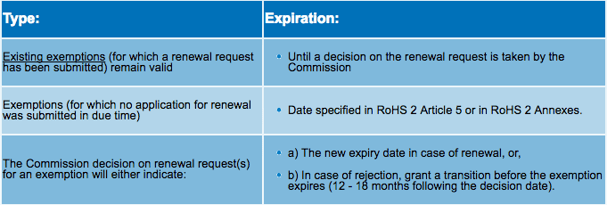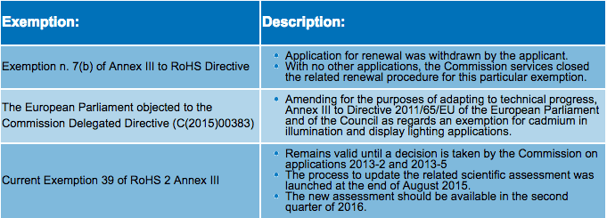Since 2011, European RoHS Directive (2011/65/EU) recast has constricted the use of certain hazardous substances in electrical and electronic equipment. The recast directive repealed the Directive 2002/95/EC from January 3, 2013. EU Member States are expected to transition the Directive 2011/65/EU into national law by January 2, 2013.
Exemptions on the use of chemicals in certain products have been put in place because their components contain hazardous substances. The European Commission had published a number of exemptions, including exemptions on the use of:
- Lead
- Cadmium
- Mercury
- Polybrominated biphenyls
- Polybrominated diphenyl ethers
- Hexavalent chromium for specific purposes.
Since RoHS 2 was published in 2011, the Commission has initiated 11 stakeholder consultations covering 135 applications. This includes new and existing exemptions; applications, related summaries and stakeholders' supplementary information.

With so many renewal applications, it is anticipated that the Commission will make a decision on a RoHS exemption application in 18-24 months from the application date (with priority to older applications).
Here are a few other Exemptions and Directives:

According to Directive 2011/65/EU, Article 5, #2:
- For categories 1 to 7, 10 and 11 of Annex I, have a validity period of up to 5 years.
- For categories 8 and 9 of Annex I, a validity period of up to 7 years.
- The validity periods are to be decided on a case-by-case basis and may be renewed.
- For the exemptions listed in Annex III as at July 21, 2011, the maximum validity period, which may be renewed, shall, for categories 1 to 7 and 10 of Annex I, be 5 years from 21 July 2011 and, for categories 8 and 9 of Annex I, 7 years from the relevant dates laid down in Article 4(3), unless a shorter period is specified.
- For the exemptions listed in Annex IV as at 21 July 2011, the maximum validity period, which may be renewed, shall be 7 years from the relevant dates laid down in Article 4(3), unless a shorter period is specified.
The European Commission recently outlined an “Adaptation to technical and scientific progress of the RoHS 2 Annexes III and IV.” Here is a table that outlines “Requests (7 October 2014 - 21 January 2015) to renew exemptions under the RoHS Directive 2011/65/EU.” (The table was last updated at the end of March, 2015). The table outlines in greater detail what has an extended expiration date and what remains the same.
The renewal process is in full swing with many new changes potentially on the horizon.
Some exemptions will expire July 21, 2016. Be aware that these changes could impact your products in the coming months.



